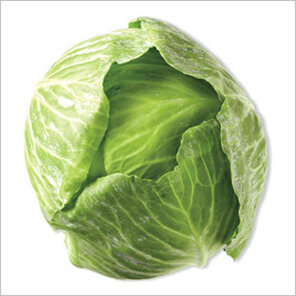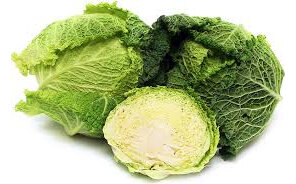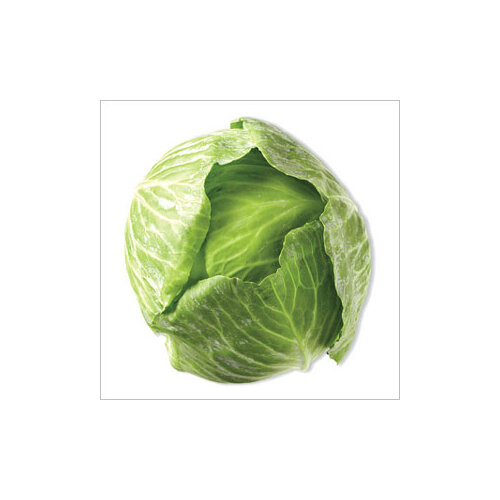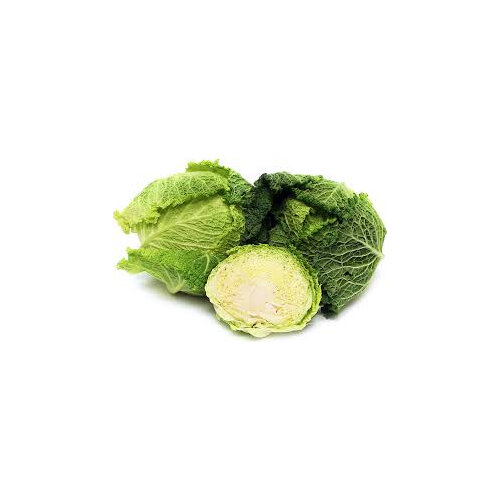Cruiciferous vegetable, who doesn't love a summer slaw or stirfry using cabbage. Great also for making your organic sauerkraut.
Cabbage has a round shape and is composed of superimposed leaf layers. It is a member of the food family traditionally known as cruciferous vegetables and is related to Kale, Broccoli, Collards and Brussels Sprouts.
The word "brassica" translates in Latin as "cabbage," and this word is being used more and more by researchers to refer to the entire group of cruciferous vegetables. You'll find many plant scientists now using the Latin word Brassicaceae and the phrase " brassica vegetables" instead of Latin word Cruciferae and the traditional phrase "cruciferous vegetables" when referring to cabbage, kale, broccoli, collards and other foods in this vegetable subgroup.
Because cabbage's inner leaves are protected from the sunlight by the surrounding leaves, they are oftentimes lighter in color. There are three major types of cabbage: green, red, and Savoy. The color of green cabbage ranges from pale to dark green. Both green and red cabbage have smooth-textured leaves. Red cabbage has leaves that are either crimson or purple with white veins running through it. The leaves of Savoy cabbage are more ruffled and yellowish-green in color. Red and green cabbage have a more defined taste and crunchy texture as compared to Savoy cabbage's more delicate nature. Bok choy as well as Chinese (Napa) cabbage are other varieties of cabbage available. Bok choy has a mild flavor. Chinese cabbage, with its pale green ruffled leaves, is great to use in salads. Red cabbage contains additional health benefits not found in green cabbage.
Sturdy, abundant, and inexpensive, cabbage is a longstanding dietary staple throughout the world and is so widely cultivated and stores so well that it is available throughout the year.
History
Cabbage has a long history of use both as a food and a medicine. It was developed from wild cabbage, a vegetable that was closer in appearance to collards and kale since it was composed of leaves that did not form a head.
It is thought that wild cabbage was brought to Europe around 600 B.C. by groups of Celtic wanderers. It was grown in Ancient Greek and Roman civilizations that held it in high regard as a general panacea capable of treating a host of health conditions.
While it's unclear when and where the headed cabbage that we know today was developed, cultivation of cabbage spread across northern Europe into Germany, Poland and Russia, where it became a very popular vegetable in local food cultures. The Italians are credited with developing the Savoy cabbage. Russia, Poland, China and Japan are a few of the leading producers of cabbage today.
Sauerkraut, a dish made from fermented cabbage, has a colorful legacy. Dutch sailors consumed it during extended exploration voyages to prevent scurvy. Early German settlers introduced cabbage and the traditional sauerkraut recipe were introduced into the United States. As a result of this affiliation, German soldiers, and people of German descent were often referred to as "krauts."
Health Benefits - Google Online :)
How to Select and Store
Choose cabbage heads that are firm and dense with shiny, crisp, colorful leaves free of cracks, bruises, and blemishes. Severe damage to the outer leaves is suggestive of worm damage or decay that may reside in the inner core as well.
There should be only a few outer loose leaves attached to the stem. If not, it may be an indication of undesirable texture and taste. Avoid buying precut cabbage.
Keeping cabbage cold will keep it fresh. Put the whole head in a plastic bag in the crisper of your refrigerator. Red and green cabbage will keep this way for about 2 weeks while Savoy cabbage will keep for about 1 week.
If you need to store a partial head of cabbage, cover it tightly with plastic wrap and refrigerate. Since cabbage starts to quickly degrade once it has been cut, you should use the remainder within a couple of days.
Tips for Preparing and Cooking
Tips for Preparing Cabbage
Even though the inside of cabbage is usually clean since the outer leaves protect it, you still may want to clean it. Remove the thick fibrous outer leaves and cut the cabbage into pieces and then wash under running water.
If you notice any signs of worms or insects, which sometimes appears in cabbage, soak the head in salt water or vinegar water for 15-20 minutes first. To preserve the cabbage cut right before cooking or eating it. Use a stainless steel knife to cut.
To cut cabbage into smaller pieces, first quarter it and remove the core. Cabbage can be cut into slices of varying thickness, grated by hand or shredded in a food processor.
Our Gingered Cabbage provides you a wonderful sweet and sour flavor.









